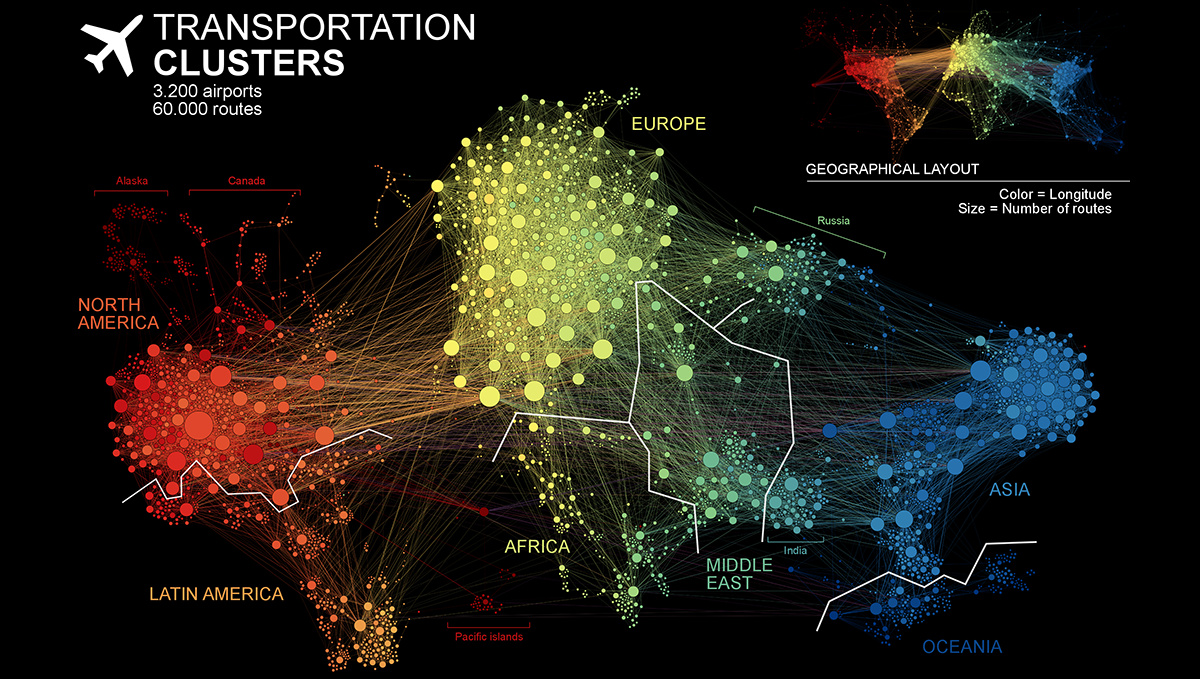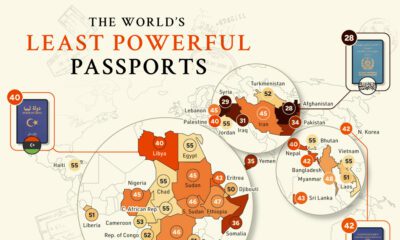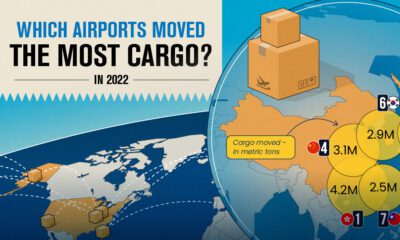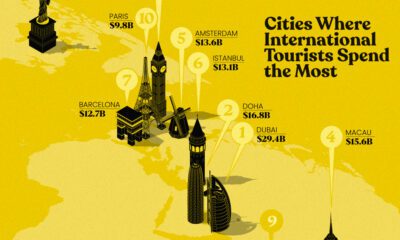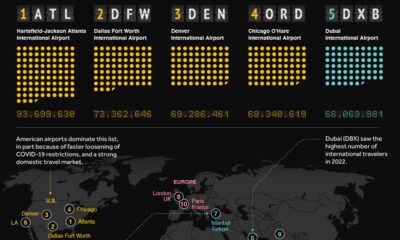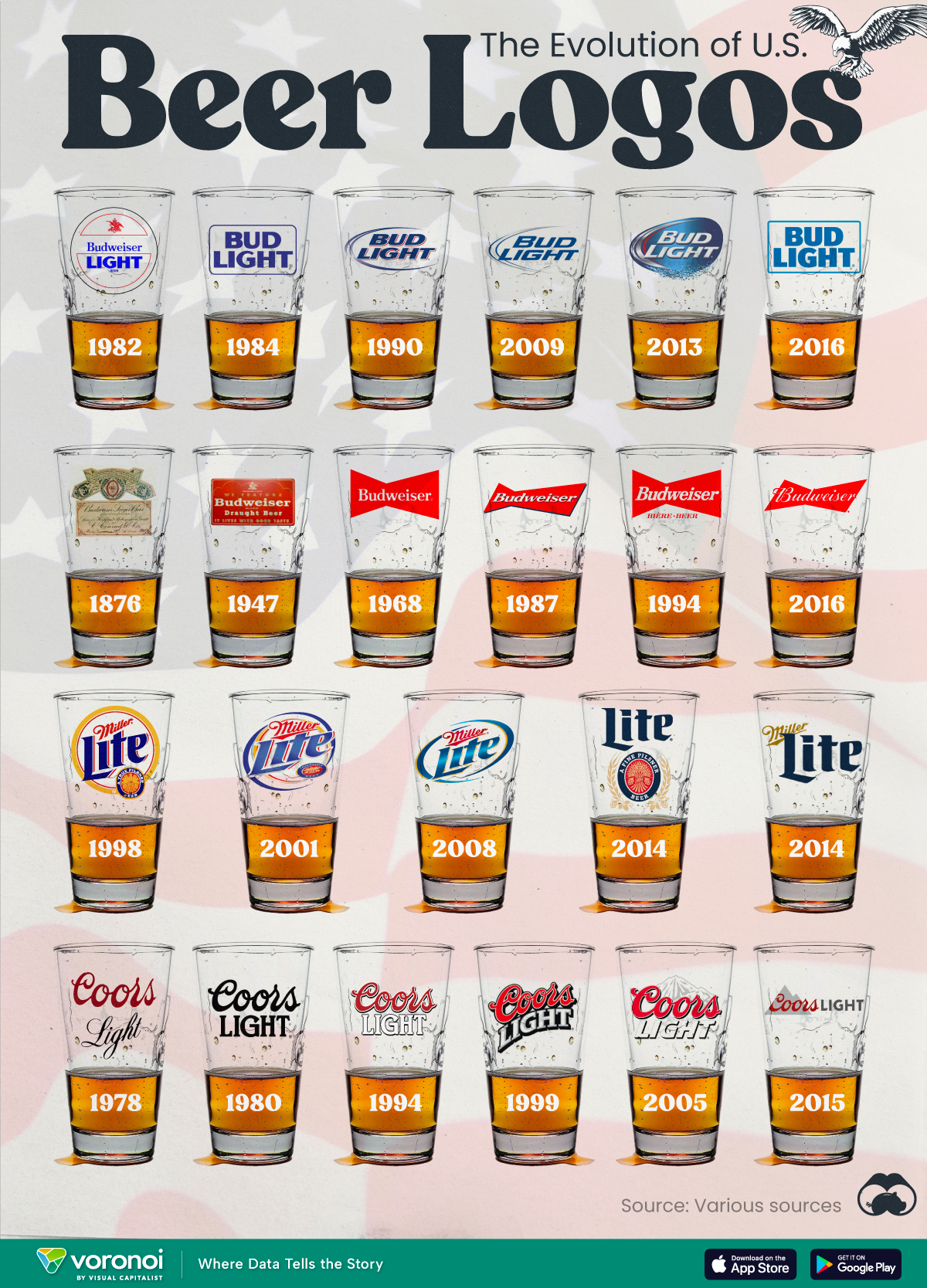Misc
A Network Map of the World’s Air Traffic Connections
View a high resolution version of this graphic
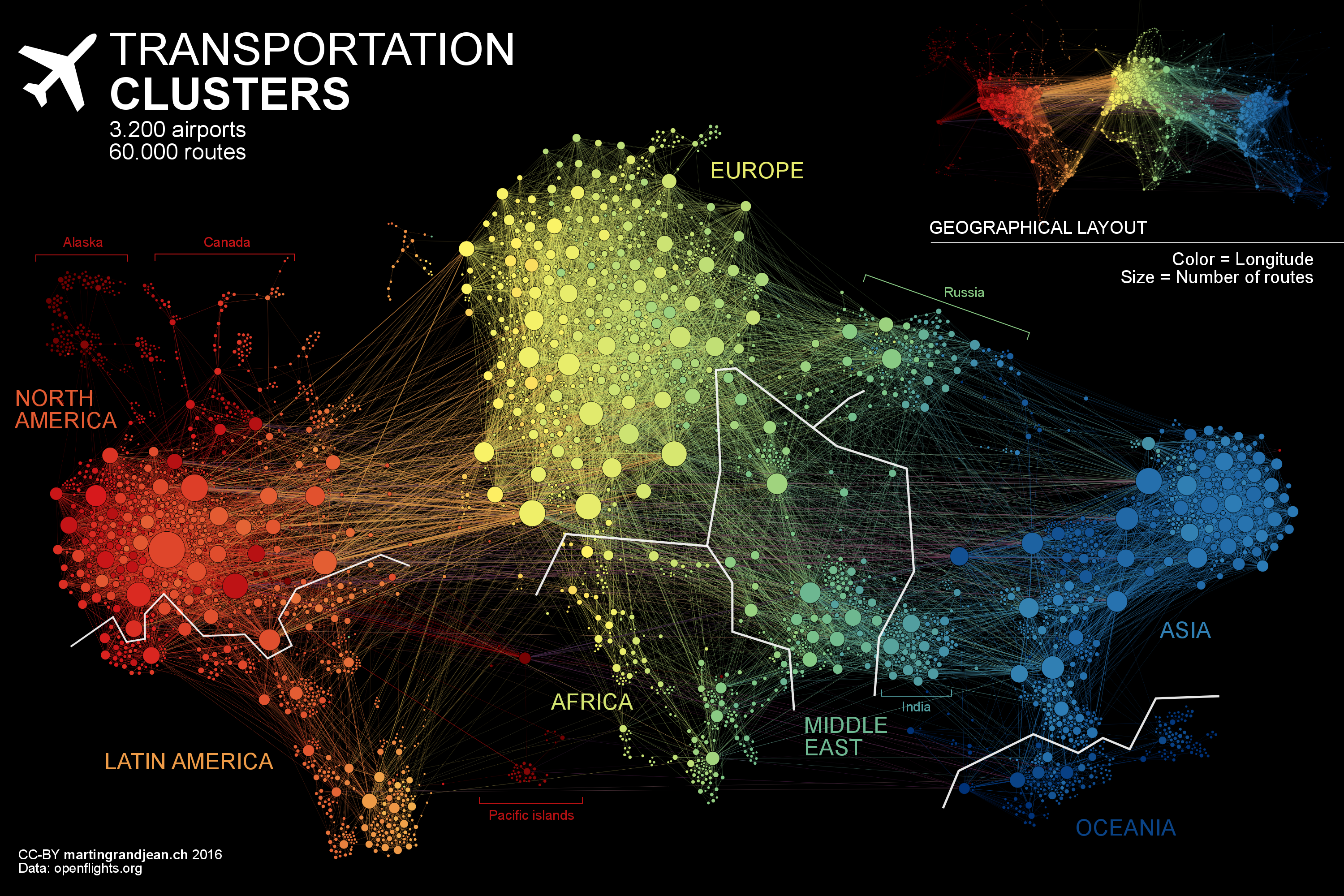
A Network Map of the World’s Air Traffic Connections
View the high resolution version of today’s graphic by clicking here.
In 2017, airlines moved over four billion passengers, a number that continues to grow each year.
As more and more people around the world can afford to scratch their travel itch, new connections and airports will be created to meet that demand. Remarkably, the world’s air transport network doubles in size every 15 years, and the International Civil Aviation Organisation (ICAO) estimates that it will do so again by the year 2030.
Today’s data visualization – created by researcher, Martin Grandjean – is a dramatic look at over 3,200 air traffic hubs that connect our world’s population centers. The unique, force-directed layout allows us to see relationships beyond geographical location.
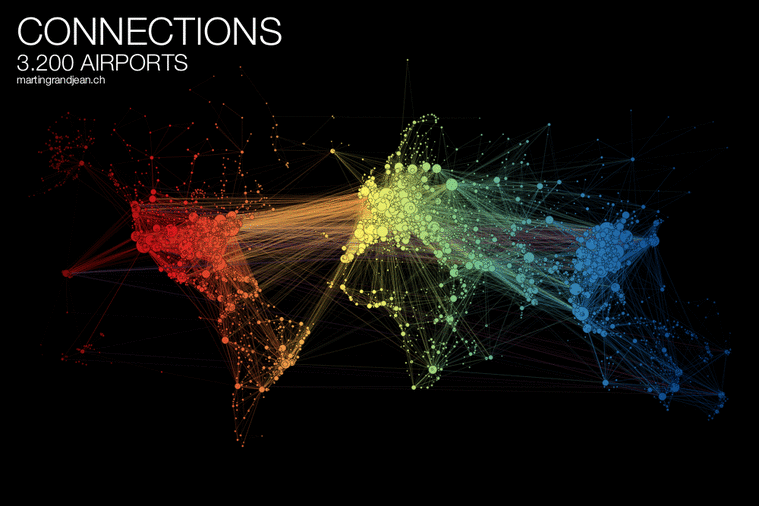
As the GIF above reveals, Europe remains an important linchpin in international travel, and cities on North America’s West Coast – such as Vancouver and San Francisco – swing in response to Asia’s gravitational pull.
The World’s Most Connected Airports
While all airports are effective at moving passengers from point A to B, particular locations play a crucial role in the global network. To help put this connectivity between airports into perspective, OAG created the Megahubs International Index.
Below are the top 50 internationally connected airports:
| Rank | Airport | Airport Name | Country | Connectivity Index |
|---|---|---|---|---|
| 1 | LHR | Heathrow | United Kingdom | 379 |
| 2 | FRA | Frankfurt | Germany | 307 |
| 3 | AMS | Amsterdam Schiphol | Netherlands | 299 |
| 4 | ORD | O'Hare | United States | 295 |
| 5 | YYZ | Toronto Pearson | Canada | 271 |
| 6 | SIN | Singapore Changi | Singapore | 257 |
| 7 | CGK | Soekarno–Hatta | Indonesia | 256 |
| 8 | ATL | Hartsfield–Jackson | United States | 256 |
| 9 | KUL | Kuala Lumpur | Malaysia | 242 |
| 10 | CDG | Charles de Gaulle | France | 242 |
| 11 | LAX | Los Angeles | United States | 235 |
| 12 | HKG | Hong Kong | Hong Kong | 233 |
| 13 | BKK | Suvarnabhumi | Thailand | 226 |
| 14 | MUC | Munich | Germany | 221 |
| 15 | IST | Istanbul Atatürk | Turkey | 219 |
| 16 | MIA | Miami | United States | 204 |
| 17 | ICN | Incheon | South Korea | 196 |
| 18 | JFK | John F. Kennedy | United States | 195 |
| 19 | IAH | George Bush | United States | 184 |
| 20 | DXB | Dubai | United Arab Emirates | 183 |
| 21 | MEX | Mexico City | Mexico | 176 |
| 22 | EWR | Newark Liberty | United States | 170 |
| 23 | PVG | Shanghai Pudong | China | 167 |
| 24 | SYD | Sydney | Australia | 167 |
| 25 | DEL | Indira Gandhi | India | 166 |
| 26 | YVR | Vancouver | Canada | 165 |
| 27 | DFW | Dallas/Fort Worth | United States | 164 |
| 28 | HND | Haneda | Japan | 163 |
| 29 | SFO | San Francisco | United States | 153 |
| 30 | FCO | Rome Fiumicino | Italy | 145 |
| 31 | PEK | Beijing Capital | China | 142 |
| 32 | CAN | Guangzhou Baiyun | China | 141 |
| 33 | BOM | Chhatrapati Shivaji | India | 140 |
| 34 | MAD | Madrid–Barajas | Spain | 138 |
| 35 | NCE | Nice Côte d'Azur | France | 133 |
| 36 | JNB | O. R. Tambo | South Africa | 133 |
| 37 | NRT | Narita | Japan | 132 |
| 38 | MNL | Ninoy Aquino | Philippines | 131 |
| 39 | SEA | Seattle–Tacoma | United States | 130 |
| 40 | BOS | Logan | United States | 128 |
| 41 | BOG | El Dorado | Colombia | 127 |
| 42 | GRU | São Paulo–Guarulhos | Brazil | 120 |
| 43 | YUL | Montréal–Trudeau | Canada | 118 |
| 44 | ZRH | Zurich | Switzerland | 115 |
| 45 | SVO | Sheremetyevo | Russian Fed. | 114 |
| 46 | SJU | Luis Muñoz Marín | Puerto Rico | 114 |
| 47 | PTY | Tocumen | Panama | 108 |
| 48 | VIE | Vienna | Austria | 107 |
| 49 | MCO | Orlando | United States | 107 |
| 50 | AKL | Auckland | New Zealand | 106 |
The heavyweight airport leading the world in international connectivity is London Heathrow. This busy air traffic hub recently had a mind-blowing 72,000 possible international connections within a 6-hour window of arriving and departing flights. Heathrow moved over 78 million passengers and 1.70 million metric tonnes of cargo in 2017.
According to OAG, Singapore Changi and El Dorado International Airport in Colombia were the most connected airports in Asia–Pacific and South America, respectively. O. R. Tambo International Airport near Johannesburg was the sole African airport to crack the top 50.
America’s Most Connected Airports
Below are the top 25 most connected airports in the United States:
| Rank | Airport | Airport Name | City | Connectivity Index |
|---|---|---|---|---|
| 1 | ORD | O'Hare | Chicago | 455 |
| 2 | ATL | Hartsfield–Jackson Atlanta | Atlanta | 390 |
| 3 | CLT | Charlotte Douglas | Charlotte | 238 |
| 4 | DFW | Dallas/Fort Worth | Dallas | 207 |
| 5 | DEN | Denver | Denver | 186 |
| 6 | DTW | Detroit Metro. Wayne County | Detroit | 139 |
| 7 | MSP | Minneapolis–Saint Paul | Minneapolis–St. Paul | 126 |
| 8 | LAX | Los Angeles | Los Angeles | 114 |
| 9 | HNL | Daniel K. Inouye | Honolulu | 104 |
| 10 | PHX | Phoenix Sky Harbor | Phoenix | 103 |
| 11 | IAH | George Bush | Houston | 102 |
| 12 | BOS | Boston Logan | Boston | 95 |
| 13 | SEA | Seattle–Tacoma | Seattle | 87 |
| 14 | PHL | Philadelphia | Philadelphia | 85 |
| 15 | SFO | San Francisco | San Francisco | 84 |
| 16 | SLC | Salt Lake City | Salt Lake City | 79 |
| 17 | MDW | Chicago Midway | Chicago | 75 |
| 18 | DCA | Ronald Reagan Washington | Washington | 65 |
| 19 | IAD | Washington Dulles | Washington | 57 |
| 20 | DAL | Dallas Love Field | Dallas | 56 |
| 21 | EWR | Newark Liberty | Newark | 54 |
| 22 | LAS | McCarran | Las Vegas | 54 |
| 23 | BWI | Baltimore–Washington | Baltimore | 53 |
| 24 | LGA | LaGuardia | New York | 51 |
| 25 | STL | St. Louis Lambert | St. Louis | 43 |
While Atlanta Airport, the second most connected hub, has more scheduled domestic capacity, O’Hare’s scheduling offered more connection possibilities for passengers. Both these powerhouse transport nodes show up very clearly on the network map above.
No Fly Zones
There is a grand total of five countries in the world that have no airport and, interestingly, they’re all in Europe. Vatican City and Monaco are simply too small to accommodate an airport.
The remaining three – Andorra, San Marino, and Liechtenstein – rely on neighboring countries and/or helicopter pads for their air travel needs.
Misc
The Evolution of U.S. Beer Logos
In this graphic, we analyze the evolution of popular U.S. beer logos like Budweiser, Coors Light, Bud Light, and more.
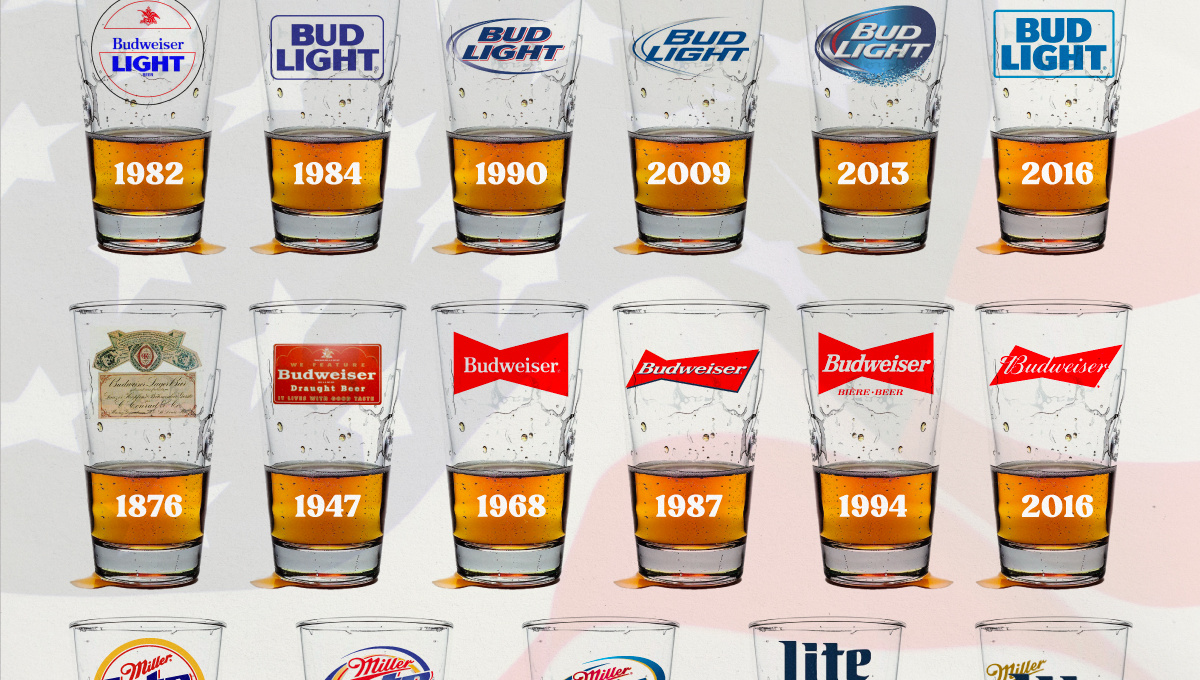
The Evolution of U.S. Beer Logos
This was originally posted on our Voronoi app. Download the app for free on iOS or Android and discover incredible data-driven charts from a variety of trusted sources.
Despite selling a popular product, beer companies have to be creative to stand out in a competitive market.
In this graphic, we analyze the evolution of some U.S. beer logos based on various sources. We chose brands based on a mixture of criteria, including popularity (based on YouGov surveys), availability of logo assets, and those with interesting developments.
Bud Light Back to the ’80s
Despite recent backlash and calls for a boycott after sending a commemorative can to transgender influencer Dylan Mulvaney, Bud Light remains one of America’s best-selling beers.
The brand of light beer, owned by the Anheuser-Busch company, has switched from its more circular logo with italic letters adopted in the 1990s back to the Bud Light badge of the 1980s. It is composed of heavy uppercase lettering, written in two levels in a shade of blue with the inscription placed on a solid white background and enclosed in a thin rectangular frame.
Miller Lite Goes Old School
After following a similar approach to Bud Light’s branding throughout the 2000s, Miller Lite decided to undergo a major rebranding in 2014.
The company returned to its 1970s roots, once again combining a white can with its original blue, gold, and red logo. The redesign was largely considered a success, given that Miller Lite sales immediately increased following the change.
A Symbol of American Brewing
The oldest brand on our U.S. beer list, the Budweiser logo, has undergone more than 15 changes over the years.
The design of two connected triangles represents a red bow tie, as a symbol of American brewing.
The colors of the Budweiser logo include a vibrant red, which helps the logo stand out and be easily recognizable from a distance. Studies also suggest that the color red stimulates appetite. Meanwhile, the white inscription symbolizes purity and cleanliness.
Curious to learn more about the beer market? Check out this graphic about global beer consumption.
-

 Economy7 days ago
Economy7 days agoRanked: The Top 20 Countries in Debt to China
-

 Demographics2 weeks ago
Demographics2 weeks agoThe Countries That Have Become Sadder Since 2010
-

 Money2 weeks ago
Money2 weeks agoCharted: Who Has Savings in This Economy?
-

 Technology2 weeks ago
Technology2 weeks agoVisualizing AI Patents by Country
-

 Economy2 weeks ago
Economy2 weeks agoEconomic Growth Forecasts for G7 and BRICS Countries in 2024
-

 Wealth2 weeks ago
Wealth2 weeks agoCharted: Which City Has the Most Billionaires in 2024?
-

 Technology1 week ago
Technology1 week agoAll of the Grants Given by the U.S. CHIPS Act
-

 Green1 week ago
Green1 week agoThe Carbon Footprint of Major Travel Methods

